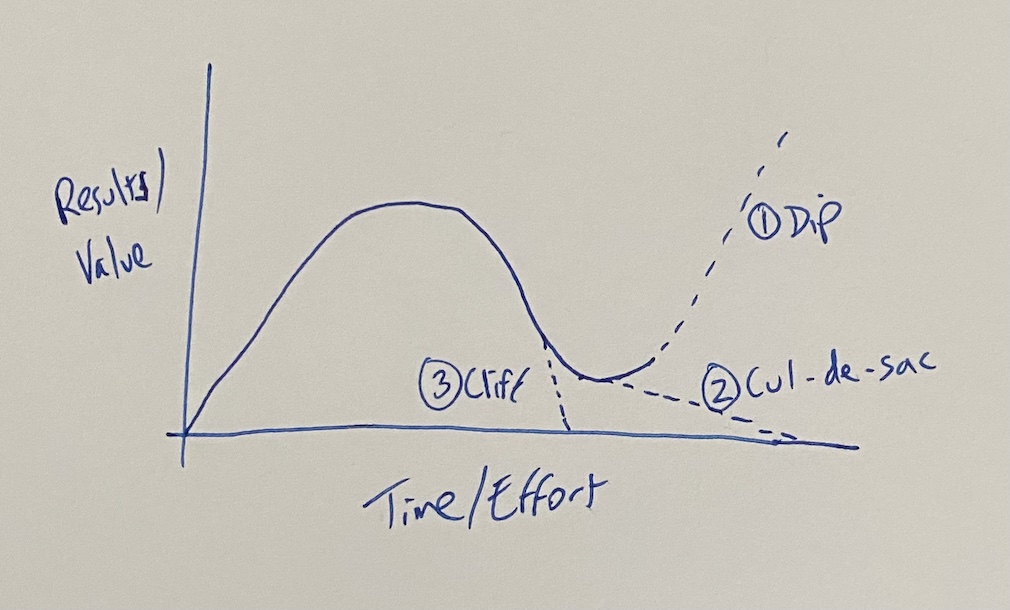

Seth Godin’s small book explores ”the Dip”, the crucial low point that happens in most projects. It could be a temporary setback or a dead end. Successful people (and organizations) get better at being able to tell the difference. They persist in dips and quit dead ends. This article will summarize the key insights and guidelines from the book and the Joosr summary of the book.
I read the “The Dip” a number of years ago. I have a vague memory of reading it in Denver Airport so I think it might have been soon after it was first published in 2007. It created a lasting impression. I reread it again during the holiday period at the end of 2021.
Insight: most projects hit a low point. It could be a temporary setback (a dip), a cul-de-sac (the French phrase for a dead end), or a cliff. They can be represented graphically like this:

Insight: Strategic quitting is the secret of success for people and organizations. Successes quit fast and commit to beating the right dip for the right reasons. Many people (and teams) quit reactively when a project becomes painful or they stick with a lost cause when they should quit.
Guideline: Godin says if you want to be a "superstar" find a steep dip and quit all the cul-de-sacs that you’re idling in. Persistent people (or organizations) see light when others can't. Smart people are realistic about not imagining a light that isn't there.
Guideline: at the start of a project decide stopping criteria so you can quit at an early stage before getting to the "dip". This can work because you’re still clear headed. At work, at the start of a project, we try to decide “acceptance criteria” so we know when we’re done. We could also define “stopping criteria” so we know if we’re in a dead end.
Guideline: continuously review active projects. The key is to determine if more hard work will lead towards long term goal or a dead end.
Guideline: if it’s a dip, lean in: push harder, change the rules, whittle away at the problems because they won't last as long. Reframe the difficult situation as a gift. Without the obstacle no learning would take place. The dip is the reason you're here. As Godin says:
"never quit something with great long term potential just because you can't deal with the stress of the moment"
Guideline: if it’s a cul-de-sac or a cliff, quit immediately. Godin calls these “the biggest obstacle to success in life”. Reframe quitting as freeing resources for the dips that matter. Quit as early as possible, ideally before you start. You have two choices for every project, quit or be exceptional.
Guideline: before quitting, ask yourself three questions:
If you’re trying to influence an individual, it's easy to cross the line and become a pest. It's hard to change someone’s mind when they’ve made it. If you’re trying to influence a market, most of the people probably still haven't heard of you. Later when your product or service get’s better they'll influence each other.
Guideline: view quitting as a positive tool. Write down some positive statements about how would quit. For example, "quitting would enable me to rededicate my time..."
Random bonus insight: Godin says "Selling is about a transference of emotions, not a presentation of facts." The attitude of the sales person is transmitted to the prospect and changes the dynamic. If the seller is committed to selling because there’s a benefit to the prospect then that comes across.
Aside: it’s interesting to see how the examples in the book have aged. At the time Godin wrote the book, Netflix sent DVDs in the mail and the space shuttle was still active.
I have a feeling that Godin’s insights could be extended by connecting them with ideas like the rollercoaster curve of a startup company or cost-of-delay estimations for project value. I hope to return to this in future posts.
For now, thanks for reading…
If you have any other examples or feedback please comment/follow/share below or on: twitter, medium or linkedin.
If you’d like to write for LearnShareDo, please send an email to (write at learnsharedo dot com).
Credits: Photo by Maria Teneva on Unsplash
Disclosure: some links in this post may use Amazon affiliate links.
Ger
January 30, 2022
Book